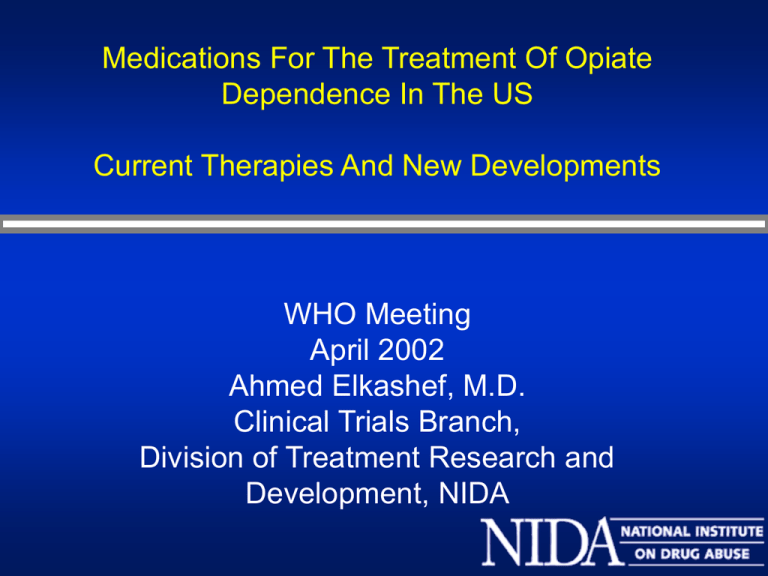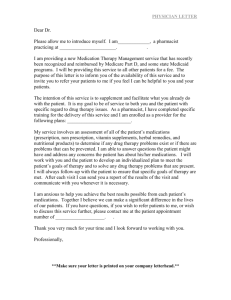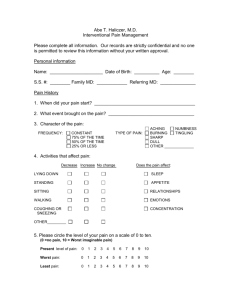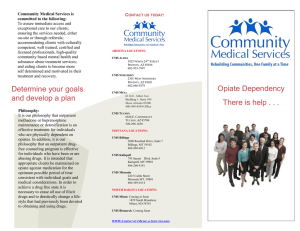MEDICATIONS FOR THE TREATMENT OF OPIATE DEPENDENCE
advertisement

Medications For The Treatment Of Opiate Dependence In The US Current Therapies And New Developments WHO Meeting April 2002 Ahmed Elkashef, M.D. Clinical Trials Branch, Division of Treatment Research and Development, NIDA Current Therapies • • • • • Methadone LAAM Buprenorphine Naltrexone Lofexidine ( in some countries) Current Needs Greater availability of treatment Medications for special populations Non-opiate medications for opiate dependence Medications to Treat Withdrawal Medications to Treat Relapse METHADONE MM and Addicts’ Risk of Fatal Heroin Overdose Authors Country # of Ss Comparison Groups RR Gearing, 1974 USA 14,474 1,170 Maint/ Discharged 0.27 Cushman, 1977 USA 1,623 291 Maint/ Discharged 0.32 Gunne, 1981 Sweden 34/32 MM/No MM 0 Gronbladh, 1990 Sweden 1,143 1,406 MM/ Discharged 0.25 Poser, 1995 Germany 149/167 MM/Heroin 0.22 Caplehorn J. et al., Substance Abuse & Misuse, 1996 The Effect of Methadone Treatments on HIV Seropositivity Rates All subjects were male, heterosexual IV drug users in NYC. Treatment provided was methadone maintenance. Not in Tx 50% 47% 40% Currently in Tx 30% 23% 20% In Tx 5 years No needle use since admission to Tx 17% 12.5% 10% 6% 0% A B C D C&D Novick et al., Presented at CPDD, 1985 Efficacy of Methadone Concurrent Control Studies • 100 male narcotic addicts randomized to methadone or placebo in a treatment setting • Both groups initially stabilized on 60 mg methadone per day • Both groups had dosing adjustments: – Methadone could go up or down – Placebo – 1 mg per day tapered withdrawal Outcome measures: treatment retention and imprisonment Weeks in Treatment 32 156 % Retention Methadone Group 76 56 Placebo Group 10 2 Imprisonment rate: twice as great for placebo group Relapse to IV Drug Use After Termination of Methadone Maintenance Treatment Percent IV Users 100 82.1% 80 72.7% 57.6% 60 45.5% 40 20 0 28.9% In Treatment Rate 1-3 Months Later 1 2 3 4-6 Months Later 10-12 Months Later 7-9 Months Later Months Since Drop Out 4 5 6 7 8 9 10 11 12 Ball, JC, Ross A. The Effectiveness of Methadone Maintenance Treatment, Springer-Verlag, New York, 1991 LAAM METHADONE CH3 CH3 CH3 CH2 CH CH3 O O CH2 CH N CH3 CH2 CH N CH3 CH2 CH3 O CH3 CH3 LAAM Pharmacokinetics • Converted to active metabolites • Has 2-3 day duration of action • Dosing usually three times per week but can be every other day to twice a week • Recently received “Black Box” warning from US FDA for “ toursade de pointes” arrhythmia ( 10 episodes out of 33, 000 patient exposures) Narcotic Addiction, The Treatment Gap, and The Public Health Imperative • • • • • • • 980,000 chronic opiate users in US in need of treatment At best, 180,000 in all forms of opiate treatment More than 800,000 users not in treatment 50% of all new HIV seroprevalence (@ 20,000 infections) HCV prevalence in narcotic addict population (90-95%) HBV parallels HIV infection in this population TB cases for opiate users (@ 30% PPD+) SAMHSA, 1999 SAMHSA, 1997 Estimated number in Thousands Treatment Need Rationale 1200 1000 800 Occasional 600 Hardcore 400 200 0 88 89 90 91 92 93 94 95 96 97 98 99 00 Years 1988 – 2000 (99-00 projected) ONDCP, Annual Report, 2001 Treatment Need Rationale 100,000 Total Heroin Mentions 80,000 60,000 40,000 20,000 0 88 89 90 91 92 93 94 95 96 97 98 99 ONDCP, Annual Report, 2001 Price per Pure Gram/"Dealer" Level $1,400.00 $1,200.00 $1,000.00 $800.00 $600.00 $400.00 $200.00 $- -11.11 -20.70 -30.96* Years 1981-98 82 84 86 88 90 92 94 96 98 Purity 60 51.33 50 42.83 40 30 30.61 20 19.1 10 0 *significant change Years 1981-98 82 84 86 88 90 92 94 96 98 ONDCP, Annual Report, 2001 Profile of Heroin Users in Treatment SAMHSA, 1997 More than 1 Million Persons are in Treatment, Every Day Clients in Specialty Treatment for Drugs and Alcohol (one-day census of active clients) 1,200,000 1,000,000 800,000 600,000 400,000 200,000 0 DHHS/SAMHSA, 1995-98 On Average, the Benefits of Drug Treatment Outweigh the Costs by a Margin of 3 to 1. $15,000 $13,902 Cost Benefit $12,000 $9,000 $7,954 $7,630 $5,259 $6,000 $4,160 $3,813 $3,000 $2,895 $2,051 $2,575 $2,547 $0 Ambulatory Outpatient Long-Term Residential Short-Term Residential Outpatient Methadone Short-Term Hospital CSAT, National Evaluation Data Services Report More than Half Those in Treatment are Being Treated in Outpatient Settings Percentage of Clients in Treatment, by Facility Setting Community Settings Correctional Settings Physical Health Mental Health Free Standing 4.1 8.3 Percents 12.8 20.2 54.7 0 10 20 30 40 50 60 DHHS/SAMHSA, Dec 97 Buprenorphine Buprenorphine – Current Status • Schedule V narcotic drug under the US CSA • Approved as an analgesic in US and 40 other countries • Approved for opiate dependence treatment in 26 countries (buprenorphine mono tablets) • NDA for buprenorphine mono (2 and 8 mg tablets) - “approvable” • NDA for buprenorphine/naloxone - (bup/nal: 2 mg/0.5 mg and 8 mg/2 mg) “approvable” Buprenorphine – Therapeutic Niche • Unmet need for a medication between methadone/LAAM (full agonists) and naltrexone (competitive antagonist) • Partial agonist would fit the unmet need Why Buprenorphine Was Developed Animals studies showed: • Partial agonist properties • Slow “off-rate” from Mu receptor • Limited or non-existent physical dependence • Less toxic than other opiates Value of a Dose in Dollars 14 MS 12 10 BUP 8 6 4:1 4 8:1 PBO 2:1 2 0 0 5 10 15 20 25 30 35 40 45 50 55 60 Minutes Bup 2:1 MS 4.1 Plac 8:1 Addition of Naloxone Reduces Abuse Potential • Naloxone will block buprenorphine’s effects by the IV but not the sublingual route • Sublingual absorption of buprenorphine @ 70%; naloxone @ 10% • If injected, BUP/NX will precipitate withdrawal in a moderately to severely dependent addict % Ss with 13 Consecutive Opiate Free Urines Study #999A: Buprenorphine’s Effect on Opiate Use 30 25 20 15 10 5 0 1 4 8 Buprenorphine Dose (mg) 16 Study #1008 Buprenorphine % of Good Outcome ( 8 Urines) Mono * 30 Combo 25 * 20 15 10 PBO 5 0 4/76 15/85 22/77 Number of Good Patients/Total PBO = 5.26 Combo = 17.65 Mono = 28.57 Statistics Value Prob Chi-Square 13.641 0.001 Mantel-Haenszel 13.591 0.001 Current Needs Greater availability of treatment Medications for special populations Non-opiate medications for opiate dependence Medications to Treat Withdrawal Medications to Treat Relapse Bup NX Best Practices Study #1018 To mimic actual practice after Bup NX is approved • Phase 4 Design • Non-traditional Settings • Open Label w/ Rx Dispensing of Bup (up to 24mg/day) • Flexibility (detox vs. maintenance) • Adolescents included from age 15 583 patients. 6 states (Washington, California, New York, Florida, Illinois, Texas). 38 Physicians’ offices. 33 community / clinic pharmacies. Bup NX Best Practices Study #1018, Interim Results • 16-week retention rate is currently 70% (goal for the same period, as stated in protocol, was 51%) • Drug use appears to have decreased significantly - 31.4% reported not using opiates at the 30 day followup after completion of treatment - 41% reported not using other non-opiate drugs at the 30 day follow-up after completion of treatment • HIV risk behavior appears to have decreased significantly Current Needs Greater availability of treatment Medications for special populations Non-opiate medications for opiate dependence Medications to Treat Withdrawal Medications to Treat Relapse Political Environment Children’s Health Act of 2000 Expands research and health care for children… – Substance abuse – youth drug treatment programs – Mental health Special Populations… Children Pregnant women Patients with co-morbid disorders Objectives: • To assess buprenorphine for safety in the mother and fetus • To assess the neonatal abstinence syndrome following exposure to buprenorphine Controlled Trial Design: • Parallel Group • • 1) Methadone 2) Buprenorphine 3) Non-pharmacotherapy treatment Vouchers targeted at all drugs Dose Methadone 40 - 100 mg daily Buprenorphine 4 - 24 mg daily Study Criteria: Inclusion: • • • • • 18 - 40 years of age Gestational age 16 - 30 weeks Opioid dependent (DSM-IV, SCID I) Recent opioid use Opioid positive urine Study Criteria: Exclusion: • Undocumented methadone positive urine at • • • • • admission Serious medical or psychiatric illness Diagnosis of preterm labor Evidence of congenital fetal malformation Diagnosis of alcohol abuse or dependence Limited benzodiazepine use TIME COURSE OF NEONATAL ABSTINENCE SYNDROME 48 10 No neonate required treatment for NAS 8 Mean Score 6 4 2 0 0 1 2 3 4 5 6 7 8 9 10 Days Postpartum Conclusions: • Mild, short-lived NAS that may differ from methadone • Sufficiently safe to conduct a double-blind randomized controlled trial Special Populations – Co-Morbid Disorders… High rates of depression are seen in both treatment seeking and non-treatment seeking opiate dependent subjects Potential Treatment: Nefazodone Current Needs Greater availability of treatment Medications for special populations Non-opiate medications for opiate dependence Medications to Treat Withdrawal Medications to Treat Relapse Lofexidine • Alpha 2 agonist similar to clonidine • Less hypotensive effects • Current Phase III trial of 3.2 mg lofexidine versus placebo in an opiate dependent population undergoing withdrawal • May be tested for prevention of relapse Lofexidine Phase III • 11 Day Inpatient study • 96 Opiate-Dependent subjects, 64 enrolled • Sites: UCLA, UPenn, Columbia Study initiation: May 2001 Completion Date: October 2002 Current Needs Greater availability of treatment Medications for special populations Medications to Treat Withdrawal Non-opiate medications for opiate dependence Medications to Treat Relapse Non-Opiate Medications… Exempt from provisions of the NATA Less abuse liability? Available to a greater number of dependent individuals? Potential Non-opiate Medications: Alpha-2-Adrenergic Agonists - Lofexidine NMDA Antagonists - Memantine Ultra Rapid Opiate Detoxification (UROD) Current Needs Greater availability of treatment Medications for special populations Non-opiate medications for opiate dependence Medications to Treat Withdrawal Medications to Treat Relapse Hypothetical Time Course in the Reinstatement Procedure Responses Maintenance Initiation Priming Drug Injection Saline Extinction Testing Session Erb, Shaham & Stewart 1996 Responses in 3 h (Active Lever) Effects of SC Injections of the Non-Peptide CRF Antagonist, CP-154,526, on Stress-Induced Reinstatement A. Cocaine-trained rats 60 45 B. Heroin-trained rats No stress Footshock (15 min) No stress Footshock (10 min) * 30 * 15 0 Veh 15 * * 30 Veh 15 30 CP-154,526 Dose (mg/kg, SC) Shaham et al Relapse Medications… Important for use after detoxification from opiates has been achieved High recidivism rate – 82% relapse to iv opiates within 1 year after discontinuing methadone Only 1 approved medication to date Relapse Medications… Opiates: Naltrexone (FDA approved) Non-Opiates: Alpha-2-adrenergics - Lofexidine NMDA Antagonists CRF Antagonists - Memantine Depot Naltrexone • Oral naltrexone has been available for over 15 years • Depot dosage forms are desirable due to treatment adherence issues • Naltrexone has been shown to reduce relapse in a criminal justice population Depot Naltrexone Resulting from SBIR & contract programs Biotek Alkermes Drug Abuse Sciences Data from Phase 1 & 2A indicated that: – – No side-effects other than the discomfort associated with the injection Dose-response: Compared to the single dose, the double dose of depot naltrexone produced a more effective and longerlasting antagonism to the effects of opiate Data from NY study on heroin challenge shown in next slide Double Dose (384 mg) Antagonized IV Heroin “high” for up to 5 weeks VAS Peak Rating (mm) 100 Placebo 6.25 mg 12.5 mg 18.75 mg 25 mg Depot NTX Dose Single 80 Double 60 * * 40 * * * * * 20 0 * * 1 2345 6 1 2345 6 1 234 5 6 Week 1 2345 6 1 2345 6 Depot Naltrexone Phase 2 outpatient trial (Biotek) Two months outpatient trial 60 subjects, 18 enrolled Sites: UPenn (O’Brien) and Columbia (Kleber). Completion date: December 2002 Phase 2A Alkermes: To be initiated at IRP/Hopkins Drug Abuse Sciences ( Phase 2A completed) Proposed Future Directions… Bup and Bup NX Facilitate introduction into Office-based settings Encourage Federal / State Interactions Search for non-opiate medications to: Treat opiate withdrawal Reduce probability of relapse Evaluate Treatment Potential of CRF Antagonists Stress-induced Drug Seeking Evaluate Treatment Potential of Kappa Antagonists






